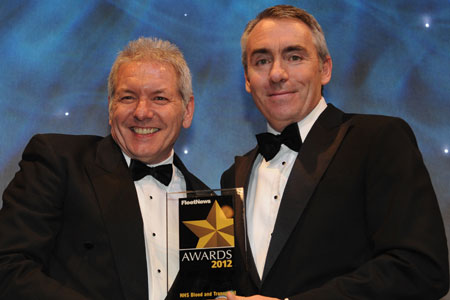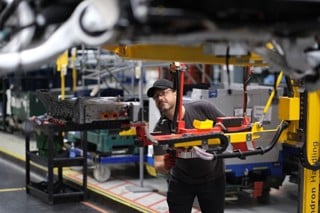NHS Blood and Transplant (NHSBT) keeps its liveried fleet of 500 vehicles in good condition yet over a three-year period it was hit with 160 end-of-contract damage charges from its leasing provider, amounting to £82,427.
“We look after our vehicles,” says Larry Bannon, national fleet service manager at NHSBT.
“We do about 35,000 miles year in our vans but it’s generally less arduous work. When they go back they do have nicks and scrapes but they’re not heavily damaged.
“We know that when they went back to the leasing company and they put them through auction they were generally getting higher than the average book price.”
After witnessing his ‘damaged’ vehicles going through auction and fetching above CAP, Bannon decided it was time to call the leasing company in for a chat. “To its credit it said ‘we’ll work something out’,” he says.
The solution was to no longer issue damage charges. Instead, NHSBT entered into a profit sharing agreement with its leasing provider.
The agreement is based on CAP prices for the month of auction, plus a 5% uplift (which acts as a ‘cushion’ for the leasing company).
“Anything that they achieve above that we split 50/50,”Bannon says. “Anything that is below that we pay in full because that’s generally down to excessive wear and tear.”
The scheme is delivering savings for NHSBT – in the first 18 months of the scheme it was in credit by £9,558.
Fleet News: Does the scheme still work when the used vehicle market is down?
Larry Bannon: Yes, comparing it against the end-of-contract damage charges we would have paid it is still a winning scheme. We know what we would have paid because we still get an independent assessor’s report.
FN: Are you confident that the inspections are fair now?
LB: Yes. I do a random sample every so often and whenever I’ve asked for the detail it’s been spot on. I have to trust my supplier but they give me no reason to doubt them. When I’ve gone and looked at the auction prices they are exactly as they say they are.
FN: What are the other benefits of the scheme?
LB: There’s an administration saving. I used to spend an inordinate amount of time going through every single invoice that came through, looking at the photographs, looking at the costs, phoning them up, disputing and then coming to an agreement.
FN: Tell us about your VAT reclaim initiative.
LB: The Department of Health introduced Contracted Out Service Guidelines (COS 26) which stated that VAT was only reclaimable on hire vehicles with repair and maintenance included.
But we have a separate maintenance provider. That meant we could reclaim the VAT on the maintenance but not on the lease cost.
I went to our finance department about it and they spoke to their VAT advisers. Then we started to engage the leasing companies and solicitors.
The solution was an overarching contract between the lease companies, the maintenance company and NHSBT, along with a combined invoice.
We put it to HMRC and they agreed it was a compliant system. We’ve been doing that for two years now and have been audited in that time.
We’re saving £600,000 a year, a saving which the NHS can invest in patient care.
FN: Why do you use a separate maintenance provider?
LB: We wanted one maintenance provider who would take ownership of our fleet so that when one of our vehicles is in the workshop for any reason then urgency is applied.
We’re essentially an emergency service and we need to make sure our vehicles are available all the time. If we had four or five different suppliers on contract hire we would have to deal with four or five maintenance con-trollers and the urgency might not be applied.
FN: How are you tackling rising fuel costs?
LB: We’ve put bulk fuel tanks in all our major centres so we can get an element of bulk buying discount.
Our vehicle replacement policy on our liveried fleet is that we will replace a vehicle with one that has equivalent CO2 emissions or less. If we’re replacing with lower CO2 we’re going to get some savings on fuel.
We’re also investigating a product called Lightfoot which works on Ford Transit vans. The trial has showed impressive results. If we put it on all 145 Transits we expect to save 11.2% in fuel.
FN: How are you reducing CO2?
LB: On the lease car scheme we incentivise drivers to choose lower CO2 vehicles. The cost of the car allowance is made up of the cost of the lease, the cost of insurance and Class 1A National Insurance.
If they choose a car below 150g/km we knock 10% off the cost of the insurance so the car is cheaper for them. If they choose a car with emissions higher than 150g/km we add 10% on.
The baseline is lowered every two years so in 2014 it will go down to 140g/km.
We are also hoping to make significant mileage savings on our liveried fleet by introducing a transport management system. We will be able to input labour and vehicle availability and it will work out optimum rosters.
It will also ensure we don’t have two vehicles going in the same direction at the same time, or in the same location, which will improve the service we give to our customers.
Bannon has been keen to take on responsibility for the grey fleet and, as of January 1 this year, he has introduced a new policy to look at grey fleet drivers’ insurance certificates and driving licences, and to check their vehicles are taxed and have the appropriate MOT.
The system will flag up when renewals are due and drivers will be expected to produce their new documents each time. Previously employees simply made a declaration on the expenses system.
A travel hierarchy has been introduced to ensure that using private vehicles for business is a last resort. A hire car must be used for round trips of more than 200 miles.
A salary sacrifice scheme, which launched in September last year, is also on offer.
High-mileage grey fleet drivers may in future be offered a lease car. If they choose to continue using their private car for business journeys NHSBT will have the option to reimburse them at the public transport rate rather than the Approved Mileage Allowance Payment (AMAP) rate.
“It’s been one of the most emotive initiatives I’ve ever had to do in my career and I’ve been doing fleet a long time,” says Bannon. “Staff haven’t necessarily been negative but they’ve been cautious.
“We had a long consultation period with union representatives to let them understand that it’s not a policy that is out to penalise anyone.
"It’s to protect the organisation as well as protect the individual.”





















Login to comment
Comments
No comments have been made yet.